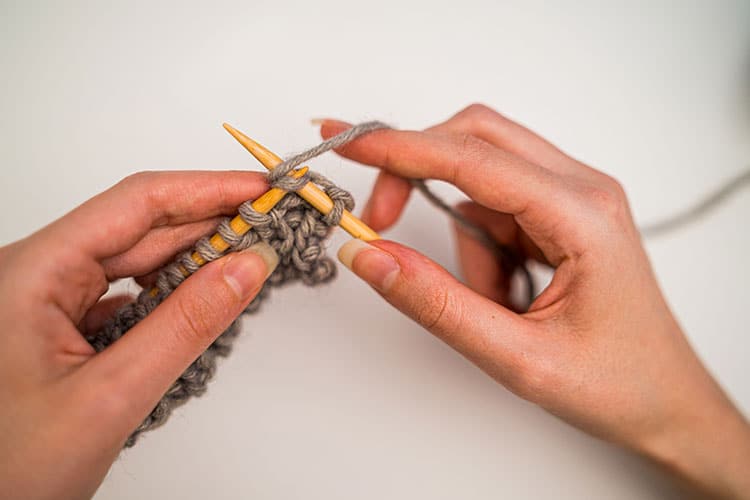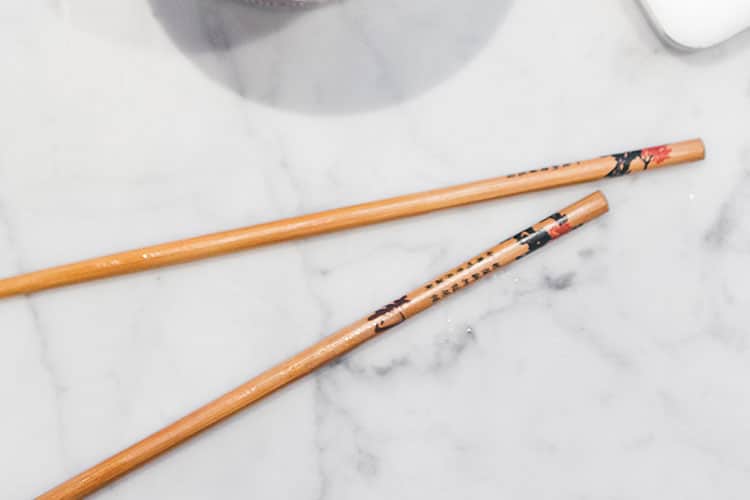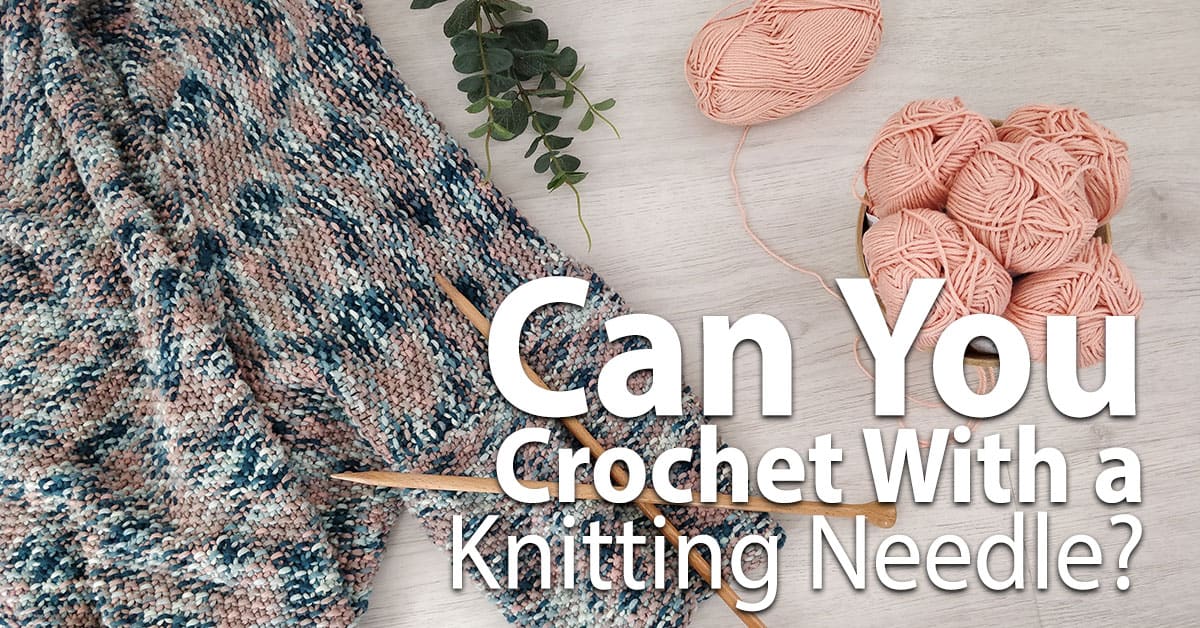Not long ago, a friend found herself in a tricky situation. While quickly grabbing a crochet project before running out the door, she left with knitting needles instead of a crochet hook. She shared the experience of trying to determine: is it possible to crochet with knitting needles?
Unfortunately for her situation, the results were not promising. Crocheting with a knitting needle is next to impossible because the hook is missing. It’s not that it cannot be done, but without the element of a hook, it’s difficult to create a crochet stitch with a knitting needle. Each stitch must be manually held to the knitting needle and pulled one by one onto the chain. This leads to poor stitch quality and is incredibly slow. The finger motions are also awkward and over time could lead to some very sore hands.
While a knitting needle might not be the best solution if you find yourself without a crochet hook, there are some simple options to keep your DIY project rolling.
Finger Crochet

One option is to skip the crochet hook altogether and try finger crochet. Finger crochet is a method to create regular crochet stitches only using your finger as the hook. It is typically worked with soft, bulky yarns (see below for more ideas about hook-free crochet projects) and patterns with simple crochet stitches.
Finger crochet can also be handy for situations where crochet hooks are prohibited for safety reasons (international flights, psychiatric facilities, etc.) Finger crochet can also be a fun fine motor challenge for young children or for anyone looking for a new yarn craft.
There are many good resources for learning to crochet without a hook online and in print. Try a Youtube search for “How to Crochet Without a Hook” for step-by-step visuals. The basic steps of finger crochet are similar to standard crochet, starting with a slip knot, and looping the tail of yarn over your fingers and through the knot to begin the chain. Once the chain is the correct length, begin using your finger just as you would the crochet hook, inserting it into the chain, looping the yarn over your finger and pulling it through the loop on the chain.
Other Creative Materials to Make a Crochet Hook With

If finger crochet does not seem to fit your project and you are committed to using a hook, there are some make-shift solutions that might carry you through until you can find the right crochet hook for your project. Here are some choices to craft your own crochet hook in a pinch:
First, if you find yourself with a knitting needle made out of a pliable material it may be possible (but unlikely!) to bend the end of the knitting needle into a hook shape. This will not work with metal knitting needles, only wood or poor-grade plastic. Even then, it’s unlikely you’ll end up with a useful tool. It also will permanently damage your knitting needles, making them useless for future projects. The better option is to create a crochet hook from another household object.
Make crochet hook from a pencil
Another option to make your own crochet hook is to start with a standard graphite or colored pencil and carve a hook shape out of the sharpened pencil end. Using a kitchen knife or a razor blade, carefully cut into the non-eraser end of the pencil, carving a neck onto the hook. The neck should be at least an inch and a half long before beginning to cut in the hook. Once the neck is shaped, spark a “smile” shape at an upward angle where the cut for the hook will go. Cut the hook at a 45-degree angle halfway through the pencil. Then carve out the remaining pencil wood until the end resembles a crude hook.
Make a crochet hook from chopsticks

The same process can also be done with disposable chopsticks if those are more readily available to you. Chopsticks are made from softwood like birch or bamboo. These can be easier than a pencil to carve into a crochet hook shape with a small kitchen knife or pocket knife.
Using the same process as with the pencil, simply trim the pointed end to a rounded shape, and then cut upward into the chopstick at a 45-degree angle to form the hook shape. For both the pencil and chopsticks, it may be helpful to use a nail file to sand off any sharp edges before using them.
Make a toothbrush crochet hook

While perhaps not the most practical material use, there are some tutorials online to carve a crochet hook from an old toothbrush. By cutting off the brush end and then trimming the plastic down to form a hook, you can create an inexpensive crochet hook. It certainly is an environmentally friendly choice, but making a toothbrush crochet hook requires an extremely sharp cutting tool. You would likely need to visit a craft store to find that anyway, so if you have to take the time to shop, just purchase an extra crochet hook and use that instead!
How to find the gauge of a homemade crochet hook
If you have taken the time to craft a homemade crochet hook, it’s important to know it may not fit into the same standard sizing as a manufactured crochet hook. To find the gauge of your homemade crochet hook, place the hook at the widest point on a tape measure or ruler starting at “0”. Measure the diameter (length across) of the crochet hook in millimeters. Then use a conversion chart to determine the equivalent US sizing.
Related Questions

What types of projects are good to crochet without a hook?
Using the finger crochet method, it is possible to create many of the same projects you would use the standard hook method for. Finger crochet projects are best created with the basic crochet stitches. These could include a series of chain stitches, the standard double stitch, or the half double crochet stitch. It is not recommended to choose projects that include treble stitches or bobbles as your fingers likely cannot hold the stitches properly.
Projects with bulky weight yarns, t-shirt yarns, or roving fabric yarns are all good choices. It’s also best to look for patterns that can be made with large crochet hooks (those sized J or higher). Good patterns to search for might include scarves, cowls, bulk-weight blankets, or tote bags.
Can You Knit with a Crochet Hook?
What about the reverse scenario when you would like to work on a knitting project but only have a crochet hook available? This option seems to have a much easier solution.
There are two techniques to create a knitted fabric using a crochet hook instead of knitting needles. The first is called Knooking “pronounced nook-ing” and uses a special crochet hook with a hole at the opposite end as the hook. A cord is looped through this hole on which the stitches hang, just like in knitting. There are many products you can buy to learn knooking and practice with the special hook.
The other technique to create knitted fabrics with a crochet hook is the Tunisian Knit Stitch. This also requires a special type of hook called an afghan hook or a “Tunisian hook”. Tunisian hooks are longer than a traditional crochet hook and have a stopper on the end that helps hold the large number stitches needed to create the knitted look.
If you are familiar with the hand movements of crochet, learning either of the Knooking or Tunisian Knit Stitch techniques gives you a similar output as knitting without having to learn a new motor movement or buy knitting needles. The stitches can be trickier to learn than basic crochet stitches though, so it is recommended you have some basic crochet experience first. For an experienced crocheter, it is certainly worth the challenge and can be an easy way to translate knitting patterns into a crochet project.
Can You Ever Use Both a Crochet Hook and a Knitting Needle?
Similar to the Tunisian Knit Stitch and Knooking, there are projects when you might combine your knitting and crochet tools. One popular method to cast on crochet projects called the “Two Needles Method” uses both a crochet hook AND a knitting needle. The stitches are placed on the knitting needle during casting on for an even, professional-looking edge. Once the initial chain is completed the knitting needle is set aside and the project continues with only the crochet hook.
There are also patterns that combine knitting stitches with crochet embellishments. In these instances, you likely would not use the knitting needles and the crochet hooks at the same time, but you use them within the same project. For example, the pattern might involve knitting a pair of tall socks but then using a crochet hook to create a cuffed, decorative boot topper.

